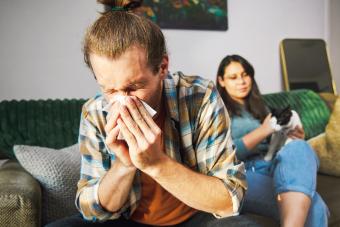
If you love cats but don't like vacuuming, non-shedding cat breeds are the answer. Although there's technically no breed that doesn't shed at all, there are several that shed very little. When a breed is referred to as "non-shedding," it simply means that the amount of hair the animal regularly loses is minimal. These include hairless cats and one long-haired breed that will definitely surprise you.
1.Sphynx

The Sphynx is what most people think of when they hear "non-shedding cat breed." This breed is the result of a naturally occurring genetic mutation that affects their hair. Sphynx are considered a hairless cat breed, although they do have a fine, downy coat that covers their body. Even though they don't shed, Sphynx cats need other grooming maintenance like frequent baths and skin care to keep them healthy.
2. Don Sphynx

The Don Sphynx, also known as the Donskoy, resembles the Sphynx, but it's not the same breed. One major difference is that the hairless gene in the Don Sphynx is dominant, making it easier to get the hairless type when cross-breeding. Usually, the cat has a short, fuzzy coat that it gradually loses in the first 2 years of life, making the Don Sphynx closer to the truly hairless cat.
3. Peterbald

The Peterbald is a cross between the Don Sphynx and the Oriental Shorthair. Their coat can range from completely hairless to a soft velour or wiry hair, called "brush." Regardless of the type, you don't have to worry about shedding with this unique cat breed.
4. Cornish Rex

The Cornish Rex has a thin, curly coat that doesn't shed much. This breed is missing both the guard and the awn layers of their coat, which are the outer two coat layers that many other breeds have. Instead, they just have soft down fur that lays close to their skin.
5. Devon Rex

The Devon Rex is another one of the low-shedding cat breeds that has a curly coat. It has both the down and the awn layers and is missing only the guard hair, so it may shed a bit more than a Cornish Rex would. The look is very similar for both of these cats, although they are unrelated.
6. Bengal

The Bengal's short hair isn't like most cats, which is why they are low shedders. The breed is a hybrid cross between a domestic house cat and an Asian leopard cat. Bengals have a pelt similar to their wild ancestors, so it doesn't shed the way most cats' fur does.
7. Siberian

You might not believe that the Siberian cat breed is low-shedding just by looking at them, but it's true. Siberians shed less than most other cat breeds. In addition, they produce the lowest levels of Fel d1, the protein in a cat's saliva that triggers cat allergies, of any cat breed.
Researchers have been working to find a way to neutralize Fel d1 using an anti Fel antigen. The ingredient is still be analyzed for safety, but may allow for low-allergen cat foods in the future.
Sign up for our newsletter featuring all the latest stories and products we love.
Non-Shedding Cats Aren’t Necessarily Hypoallergenic

There is a misconception that people are allergic to the hair of cats, and so a non-shedding breed will keep allergies at bay, but that's not entirely true. Cat allergies are caused by the presence of a particular protein in the saliva. This actually has very little to do with the hair except for the fact that cats clean themselves with their tongues, and the dried saliva flakes become part of the dander released by the cats. However, some breeds, like the Siberian, do produce lower levels of the protein, which makes them a better choice for people with cat allergies.
Daily Grooming Helps Keep Cat Shedding to a Minimum

On the other hand, if you're looking for a low-shedding breed because you dislike vacuuming, one of these breeds may be perfect for you. By grooming your low-shedding cat daily, you may find that there does not seem to be any shedding at all.
Non-Shedding Cats Need More Care

Be aware that the non-shedding breeds need a little more care when it comes to keeping them warm and comfortable, so take that into consideration when making your choice. Due to their lack of a normal coat, hairless cat breeds should be kept indoors because they can get sunburned and are easily bothered by the cold. That is, unless you get a Siberian cat, which is the only long-haired cat breed that does not shed.







